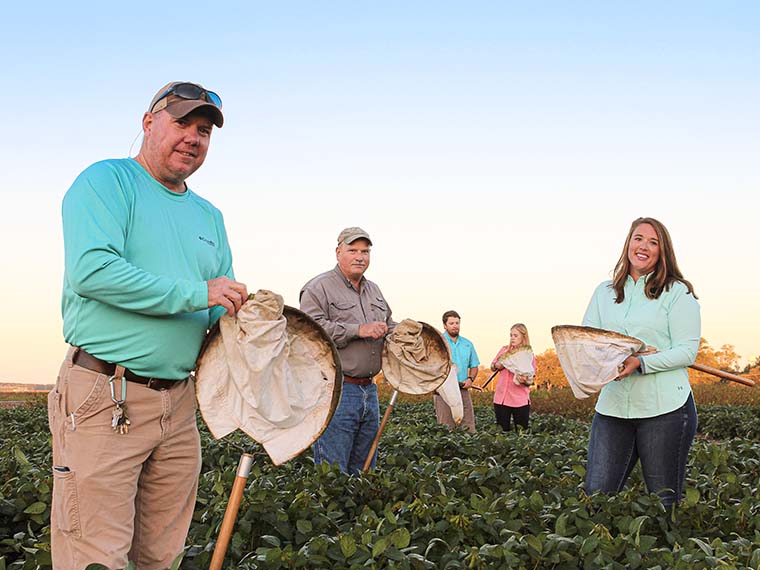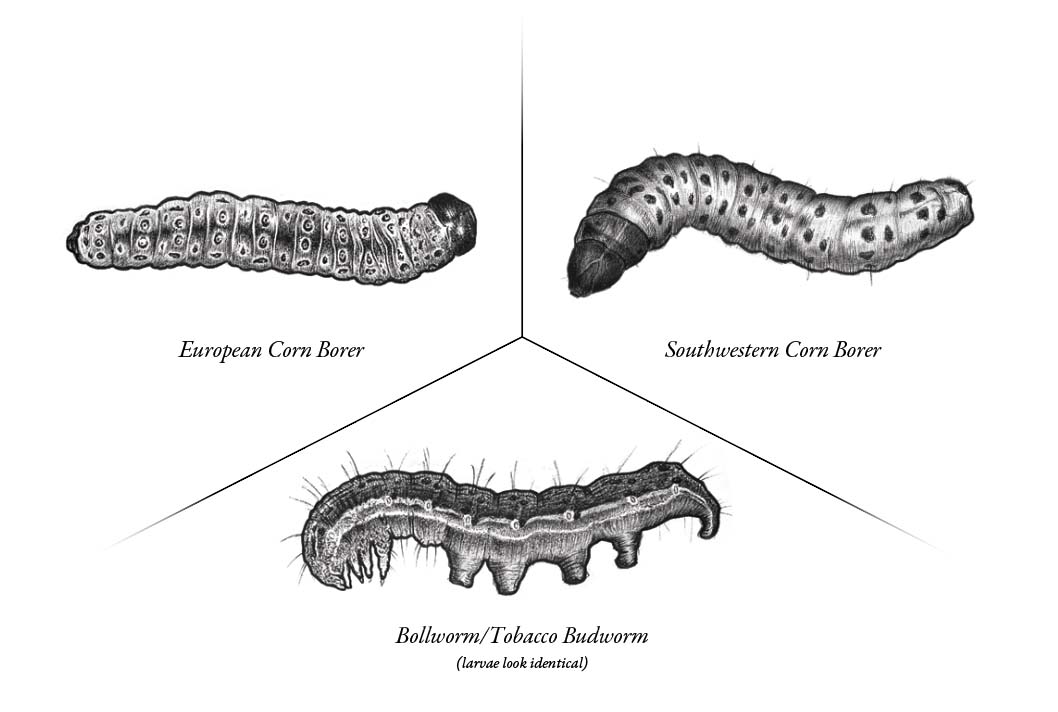Targeting Pests
MAFES scientists addressing bollworm resistance to Bt crops
By: Kenner Patton
The information presented on this page may be dated. It may refer to situations which have changed or people who are no longer affiliated with the university. It is archived as part of Mississippi State University's history.
VARIABILITY IS THE NAME OF THE GAME when you are farmer. Uncertain weather, expenses, and markets are just a few of the challenges that can make or break agricultural producers. With all of these unknowns, there are still other concerns for producers that are expected yet unwanted, particularly in the South, namely insects.
According to the Food and Agricultural Organization of the United Nations (FAO), herbivorous insects are responsible for destroying one fifth of the world's total crop production annually. While pests were first documented to cause problems for farmers as early as 2500 BC, breakthroughs in technology have eased some of the disruption caused by foraging anthropods.
The discovery of a naturally occurring soil bacterium, Bacillus thuringiensis (Bt), was made by Japanese biologist Shigetane Ishiwatari in 1901, while researching the population loss of silkworms. In 1915, German scientist Ernst Berliner discovered the same organism infecting flour moth larvae in central Germany. During the mid-1900s, American scientists conducted basic and applied research that demonstrated Bt's potential as a microbial insecticide, with the first foliar Bt insecticide product used in 1938. When ingested by a susceptible insect, the Bt proteins are activated, thus dissolving the insect's gut lining rendering it unable to eat.
Dr. Don Cook, associate research professor at Delta Research and Extension Center explained the process.
"As Bt develops, proteins that are toxic to certain insects are produced. Different types of proteins are produced during different stages of development. The most common ones are crystalline, or Cry proteins that are produced during the reproductive stages. Cry proteins have been used extensively in foliar Bt insecticides. Almost all of the Bt genes/traits in Bt crops are for producing Cry proteins in Bt plants. These include the single and two gene Bt corn and cotton technologies. Another type of protein, called Vip proteins, is produced during the vegetative stage of bacterial growth. In addition to Cry proteins, Vip proteins are expressed by the 3-gene corn hybrids and cotton varieties," Cook said.
Bt crops are created by inserting genes into the plant's genome, causing the plant to produce proteins toxic to certain insects. In modern agronomic insect pest management, Bt crops/technologies are some of the most effective tools. Most commonly associated with cotton and corn, Bt versions of soybean and some vegetables are commercially available in other countries.
The original target pests for Bt field corn and cotton were corn borers and tobacco budworm, respectively. These original technologies/traits are very effective against these pests. In fact, efficacy of single-trait Bt corn hybrids against Southwestern corn borer and European corn borer is greater than 99 percent. However, other insect pests, such as bollworm in cotton, required supplemental insecticide applications. The original Bt cotton efficacy against bollworm was 50-70 percent compared to greater than 99 percent for tobacco budworm. Even at a lower efficacy rate, the original Bt cotton reduced the number of supplemental insecticide applications for bollworm.
To enhance performance against pests, such as the bollworm, corn hybrids and cotton varieties that express two Bt traits were developed. These were more effective against bollworm and other caterpillar pests and have been widely adopted by growers. Although, in most situations, bollworm is not an economic pest of field corn. However, bollworm has developed some resistance to these technologies, and supplemental insecticide applications to manage bollworm in 2-gene cotton are very common.
While 3-gene field corn hybrids have been available for a number of years, they are currently not widely planted in Mississippi. Recently 3-gene cotton varieties have been commercially introduced. Both of these express a Vip protein in addition to Cry proteins. The Vip provides an additional mode of action and activity against pests that are difficult to manage, including the bollworm. Currently, the 3-gene cotton varieties are very effective against bollworm.
The focus of research and outreach on Bt crops at the Delta Research and Extension Center (DREC) is evaluating the field performance of Bt technologies, development of treatment thresholds for these crops when or if foliar applications are needed, and evaluation of performance issue events such as unexpected damage or insect survival.
"We make multiple collections of bollworm each year from 2-gene and 3-gene Bt crops planted at DREC and from growers' fields with higher than expected survival and injury," said Dr. Jeff Gore, research professor at DREC.
Gore added that insect collections are shared with cooperators across the country. Drs. David Kerns and Fei Yang at Texas A&M are the recipients of many of these and Dr. Nathan Little of USDA/ARS in Stoneville also receives part of DREC's collections. They conduct dose-mortality bioassays to determine if the susceptibility to Bt is decreasing and estimate the frequency of resistance genes in bollworm populations.
"These research and diagnostic collaborations between state and federal entities are an important part of our work, with the end goal of benefiting producers throughout the Southeast," Gore said.
The research has shown that some insects are becoming resistance to Cry proteins, including those in 2-gene corn and cotton. Historically in Bt cotton, supplemental insecticide sprays have been triggered based on fruit damage and surviving larvae. However, due to resistance, the treatment threshold in 2-gene cotton is now based on egg-counts. Additionally, the foliar insecticides currently available for bollworm management perform better when targeted against eggs and small worms instead of larger worms or those protected inside squares or bolls. Alternatively, the 3-gene cottons, that express the Vip protein, have been effective against bollworm, however, resistance alleles to the Vip protein have been detected in some bollworm populations. This suggests that resistant populations can occur quickly across the southern U.S.
From a cotton perspective, growers rarely needed to spray the 2-gene varieties when they first became commercially available, but the frequency of sprays has increased in the last few years. The 3-gene cotton reset the timeline on foliar sprays, however, the frequency of resistance to Cry proteins combined with the ability to detect resistance alleles to Vip indicates more foliar sprays will likely be needed in the near future.
"As insects become resistant to insecticides, whether a chemical or natural bacterium, such as the Bt trait that has been added to cotton and corn, new recommendations are needed for growers to reduce the impact of insects," Gore said. "This is when the collaboration between research and extension is vital to formulate those recommendations and inform growers."
Discussions between MAFES scientists and extension specialists within the state and across the Southeast begin early in the summer.
"Generally, problems show up first in the coastal bend of Texas and in Louisiana before they hit Mississippi," Gore said. "The Mid-South Entomology Working Group is utilized to keep everyone in the region up to date on what is happening during the field season."
Each year, MAFES scientists and extension specialists develop new guides for farmers and consultants to target pests set on eating their way through a farmer's profits. Bt technology is an evolving tool tailored to target pests globally. As resistance develops, MAFES scientists are paving the way to help provide farmers with the tools they need to fight pests in the field now and in the future.
"Our goal is to develop recommendations on solutions to control unwanted pests, ultimately improving the farmer's bottom line," Gore added.
This research is funded by the Mississippi Agricultural and Forestry Experiment Station; Cotton, Inc.; Bayer/Monsanto; and through a cooperative agreement with USDA-ARS, Southern Insect Management Research Unit.
As insects become resistant to insecticides, whether a chemical or natural bacterium, such as the Bt trait that has been added to cotton and corn, new recommendations are needed for growers to reduce the impact of insects.
Dr. Jeff Gore


